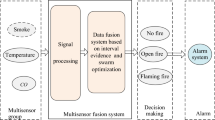Abstract
This paper proposes a switchboard fire detection system that uses the expert inference method based on improved fire probability for accurate fire identification. The conventional expert inference method has a disadvantage in that the range of the evaluation index for fire probability is limited because the defuzzification process uses a quantified set shape. To overcome this problem, we propose an improved expert inference method that uses a defuzzification correction operation after defuzzification. This technique applies a quadratic function to a range of reduced fire potentials, and then gradually expands the reduced range. The fire probability range was expanded using the improved expert inference method with the defuzzification correction operation, which also extended the fire detection range. As a result, it is expected that the fire awareness of this watchdog can be improved by the defuzzification correction operation.











Similar content being viewed by others
References
Land HB, Gammon T (2015) Addressing arc-flash problems in low-voltage switchboards: a case study in arc fault protection. IEEE Trans Ind Appl 51(2):1897–1908
Lee W-J, Sahni M, Methaprayoon K, Kwan C, Ren Z, Sheeley JM (2009) A novel approach for arcing fault detection for medium-/low-voltage switchgear. IEEE Trans Ind Appl 45(4):1475–1483
De Iacovo A, Venettacci C, Colace L, Scopa L, Foglia S (2017) PbS colloidal quantum dot visible–blind photodetector for early indoor fire detection. IEEE Sens J 17(14):4454–4459
Chi Rui, Zhe-ming Lu, Ji Qing-ge (2017) Real-time multi-feature based fire flame detection in video. IET Image Proc 11(1):31–37
Ahmad NS, Boon NL, Goh P (2018) Multi-sensor obstacle detection system via model-based state-feedback control in smart cane design for the visually challenged. IEEE Access 6:64182–64192
Ahmad A, Riaz MM, Ghafoor A, Zaidi T (2016) Noise resistant fusion for multi-exposure sensors. IEEE Sens J 16(13):5123–5124
Leal BEZ, Hirakawa AR, Pereira TD (2016) Onboard fuzzy logic approach to active fire detection in brazilian amazon forest. IEEE Trans Aerosp Electron Syst 52(2):883–890
Sowah RA, Ofoli AR, Krakani SN, Fiawoo SY (2017) Hardware design and web-based communication modules of a real-time fire detection and notification system using fuzzy logic. IEEE Trans Ind Appl 53(1):559–566
Acknowledgements
This work was supported by the Enersolar Co., Ltd. And this research was also supported by the Korea Institute of Energy Technology Evaluation and Planning (KETEP) and the Ministry of Trade, Industry & Energy(MOTIE) of the Republic of Korea (No. 20174030201470).
Author information
Authors and Affiliations
Corresponding author
Rights and permissions
About this article
Cite this article
Lee, HJ., Kim, DE., Shon, JG. et al. Switchboard Fire Detection System Using Expert Inference Method Based on Improved Fire Discrimination. J. Electr. Eng. Technol. 14, 1007–1015 (2019). https://doi.org/10.1007/s42835-019-00092-2
Received:
Revised:
Accepted:
Published:
Issue Date:
DOI: https://doi.org/10.1007/s42835-019-00092-2




